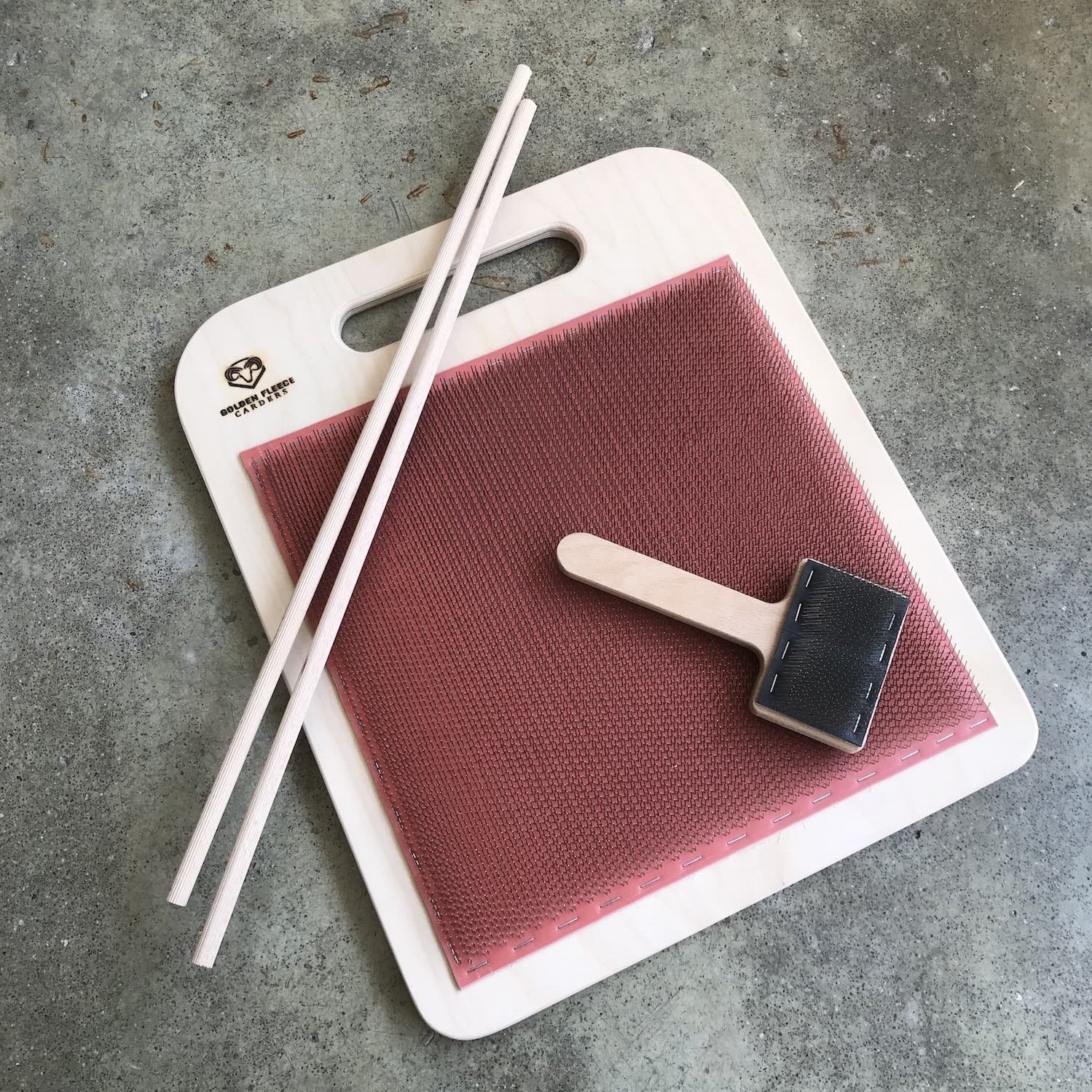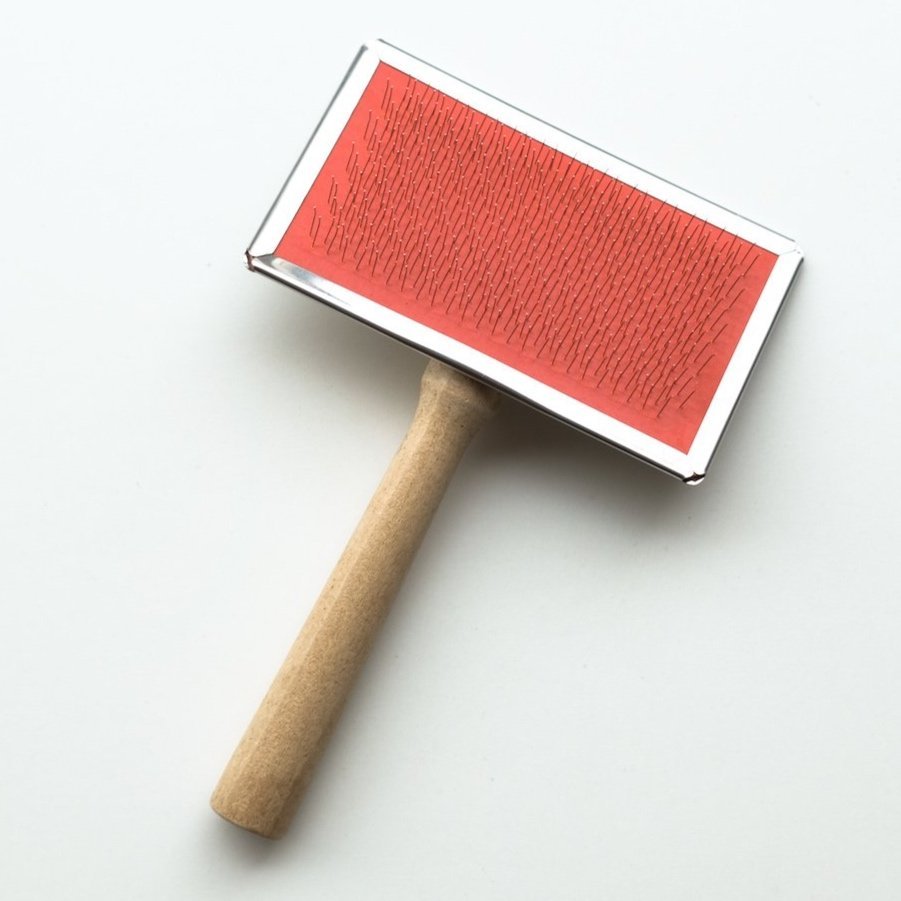Handcards, drumcarders and more: a short guide
Here's a short guide to help you choose handcards, drumcarders and other similar tools. Nowadays there are many options on the market when it comes to equipment for carding or blending fibers, so you need to know a few things before selecting the equipment you need.
Carded wool.
Carding
Carding is a fiber preparation process whose main objective is to open up the fibers and arrange them in a uniform way, suitable for spinning, felting or other purposes. Although this is the basis of the process, the equipment mentioned below allows you to do more than just card, but they are part of the same group because they all have carding cloth.
Carding cloth with metal teeth on the surface.
Carding cloth
Carding cloth is a kind of mat, usually made of rubber and fabric, with hundreds of metal teeth on its surface. Carding cloths have different tooth densities and this is one of the most important characteristics when choosing a pair of cards, carders or blending boards.
Handcards with 3 different teeth densities: 46tpi (gray cloth), 72tpi (bottom, right), 108tpi (top).
The density of the carding cloth
The density of the cloth refers to the number of teeth per inch: “teeth per inch”, usually abbreviated to “tpi”.
There are cloths on the market with 3 tooth densities: 108tpi (or 120), 72tpi and 46 tpi.
The 108-120tpi cloth, which is denser and has finer teeth, is more suitable for fine fibers. For example, merino or alpaca wool.
The 72tpi cloth, of medium density and with slightly firmer teeth, is more suitable for medium-thickness wools, such as our bordaleiro-type wools and also some of our churras.
The 46tpi cloth has very thick, not very dense teeth and was designed for thick, short fibers, which is something we don't have in Portugal. For this reason, we don't consider them suitable for use with Portuguese wools. For churra wools, we still recommend 72tpi handcards, as they are a much more versatile purchase and a better investment.
If we use less dense cards (e.g. 72tpi) with fine fibers, they won't be dense enough to separate the fibers properly and the overly firm teeth could break the fibers.
If we use dense cards (e.g. 108tpi) for thicker wools, the high density of the teeth will make the work difficult because the cards will get more “stuck” when trying to card the wool.
Therefore, we should try to choose the cloth according to the type of fibers we will be working with most often, in order to get the best results.
Different types of equipment and what they are used for
Kromski flat handcards.
1. Hand carders (pair)
Pair of hand carders.
These are the usual hand carders for carding fibers. They are always used in pairs and are available in 3 cloth densities: 46tpi, 72tpi and 108-120tpi.
They are generally available with a 19x10cm cloth, but some brands offer smaller models.
In terms of shape and ergonomics, there are 2 types of cards on the market: curved and flat.
Flat handcards have completely flat blades. Curved handcards have slightly curved blades, as you can see in the pictures.
Louet carders with curved blades.
The choice between one or the other is just a matter of personal preference, since the shape of the handcards does not directly influence the carding result. In our experience, people tend to prefer handcards identical to those they learned to card with, because the shape of the handcard doesn't affect the result, but it does affect the movements we use.
In terms of ergonomics, here at Saber Fazer we prefer Kromski's flat cards, not so much because they are flat, but because the sloping handles ensure that there are never any accidental scrapes on the fingers, which is important when teaching!
When the cloth on these cards is damaged by use, it can easily be replaced with new cloth, thus renewing the cards.
2. Drum carder
Louet drum carder.
The drum carder is a machine that has 2 drums with carding cloth and is driven by a crank. There are also electric models. Its working principle is identical to that of industrial carding machines, in which multiple drums with carding cloth carry out the carding.
The carding machine allows us not only to prepare fibers (carding), but also to mix different fibers and colors.
In our experience, having a pair of handcarders is essential, but the purchase of a drum carding machine becomes unavoidable when working with wool becomes a regular activity or we want to take advantage of the ability to mix fibers/colors with a single piece of equipment. It's always an excellent investment.
In addition to being available with different cloth densities (72tpi and 108tpi), depending on the type of fiber we're working with, the drums are also available in 3 widths, depending on the brand: 10cm, 20cm and 30cm. The choice of size depends on several factors, including budget, purpose and available space. For this reason, we always prefer to advise our customers before purchase. In our store you will find drum carders of various brands and sizes.
3. Blending Board
108tpi blending board from Golden Fleece Carders.
A blending board is a board covered with card cloth that is not used for carding (the preparation stage), but rather for mixing different types of fibers and/or colors. It is usually available in 2 densities: 72 or 108tpi.
For example, we can take wool and alpaca and create a mixture, thus enabling us to produce a wool/alpaca yarn.
Or you could mix different colored wools to spin a nuanced yarn.
The blending board is a fun and creative tool that comes in handy when you buy already combed fibers and want to create your own blends.
4. Flick carder
Flick carder from Golden Fleece Carders.
The flick carder is a small handcard with strong teeth that is used to open the individual strands so that they are immediately ready for spinning.
It is most commonly used with long wools, which are a pleasure to spin directly from the lock.
5. Mini-handcard
Mini-handcarder.
The mini-handcarder is a versatile tool, to be used for whatever you need. They can be used in pairs for carding (although they aren't as productive due to their small size and less powerful teeth!), they can be used as a flick carder, they can be used in felting to lift fibers and much more.
What matters is that it's an inexpensive tool that can come in handy when you're on a tight budget. The teeth of this mini-handcarder are of inferior strength.












